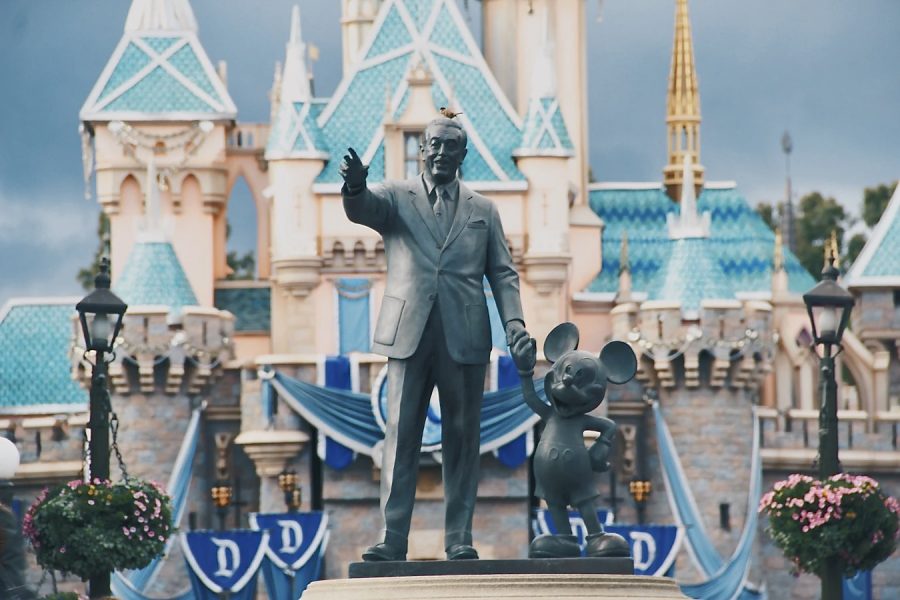The Future is Us: Disney’s New Animated Diversity Initiative
In the last five years, Disney has demonstrated a significant shift in its selection of animated heroes and heroines to reflect modern audiences.
Walt Disney’s global empire has made great strides in representing diversity over the last decade. Pictured is a statue of Walt Disney with his character Mickey Mouse at Disneyland.
A pale princess, with her golden locks softly tousled by the breeze, is lifted into her prince’s arms. Cackling witches offer a lacquered apple dripping with poison. Plump fairies hum as they grant wishes with an elegant wave of their wand. This is what I think of when I hear ‘Disney.’ Chances are that this is what you imagine as well.
However, this may not be the case for future generations. In the last decade of animated Disney films, the direction of their storytelling has quietly begun to shift. The Caucasian protagonists that once dominated the screen have stepped aside for a new generation of heroes and heroines, ones that represent us.
What does that mean? To put it simply, Disney’s new animated films are taking a shot at reflecting the unique cultural and personal backgrounds of their audience. Take the 2017 film Coco, for instance. Our protagonist, 12-year-old Miguel Rivera, lives in the fictional Mexican town of Santa Cecilia, where he endeavors to be a guitarist, much to his family’s chagrin. Already, we can imagine Miguel’s place in the real world. He has not been blessed with magic, nor was he born to royalty: he is just a kid chasing his passion. Co-director and screenwriter Adrian Molina recalled that during the design process for Miguel, “Zaruhi Galstyan did this beautiful sketch — a scrawny Mexican kid holding a guitar, crooked smile, a spark of passion in his eyes — and looking at it, I thought of the kids who would see this character and think, ‘Hey, this is a story about someone like me. I’m someone whose story is worth telling, whose experience is worth hearing about.’”
Even animated short films are reconfiguring their character narratives in order to reflect modern audiences. Perhaps you remember laughing at goofy animated antics, such as in For the Birds. In contrast, recent short films are not just for laughs. In the short seven minutes they have of your attention, Disney takes you on a journey in order to experience the world from all sorts of perspectives. The 2020 short film Loop features a teenager named Marcus and his journey to connect with a nonverbal, autistic girl named Renee. Though he is initially confused by her behavior and her unorthodox methods of communication — mostly consisting of pictures on her phone, a catchy ringtone, and murmuring — they nonetheless work together to form an understanding of one another.
Marcus comes to appreciate how Renee does not need oral communication to connect, enjoying sensations like brushing her hand over ticklish cattails or listening to a funny ringtone on loop. While writing Renee’s character and incorporating visual elements in order to convey the mood of a scene, the story writers talked with consultants from the Autistic Self Advocacy Network. Producer Michael Walsh mentions in a Forbes interview, “The color and the [lighting]…was one of the things our consultants…helped us a lot with. We had some of our lighting artists do some experiments…based on self-reporting from autistic folks about how they perceive the world. We showed those tests to our consultants and we were super surprised and really happy that they actually picked different ones than we thought they would pick.” Other important details such as her body language, facial expressions, and the casting of an autistic voice actress, Madison Brandy, brought the character to life in the the most authentic manner possible.
These films are not the only examples of a diverse perspective in an animated Disney feature. Looking at the list of all the latest and up-and-coming Disney films — Onward, Soul, Luca, Turning Red, Raya and the Last Dragon– – they all feature people from ordinary society, with different ethnic backgrounds and unique stories to tell. This is seen with the pandemic release Onward, where teenage protagonist Barley Lightfoot, who was raised by his brother and single mother, embarks on a magical journey in order to get the chance to meet his father. It is also seen with Soul, featuring middle school music teacher Joel Gardner, who dreams of being a jazz musician in New York City. The directors, upon establishing Joel’s passion as jazz, decided a Black protagonist would be best suited for the role, considering jazz’s roots in Black culture.
For young and older generations alike, the new viewpoints of these films have created a way for everyone to see themselves in a Disney film. New, stronger emotional connections can be forged with these characters, regardless of your ethnicity, appearance, or cultural background. Even more than that, now people can admire cultures from all over the world through lively animation and music on the big screen. Whether it is from the perspective of a black jazz pianist in New York City or an autistic girl appreciating the world with her senses, Disney’s divergences from the traditional fairytale adds a much-needed, magical pinch of pixie dust into our lives.
Whether it is from the perspective of a black jazz pianist in New York City or an autistic girl appreciating the world with her senses, Disney’s divergences from the traditional fairytale adds a much-needed, magical pinch of pixie dust into our lives.
Phoenix Chen is a Chief Graphic Designer and Copy Chief for ‘The Observatory’ yearbook. Her favorite part of journalism is being able to share stories...

